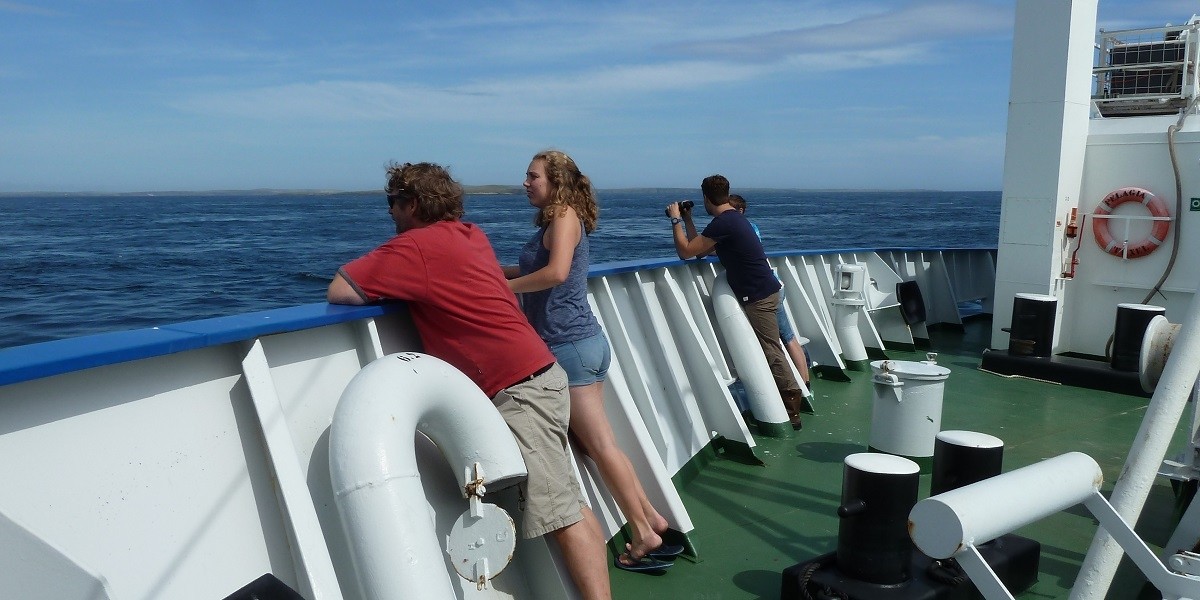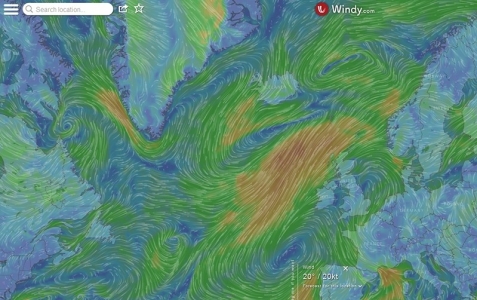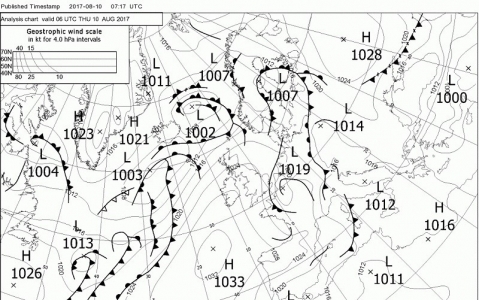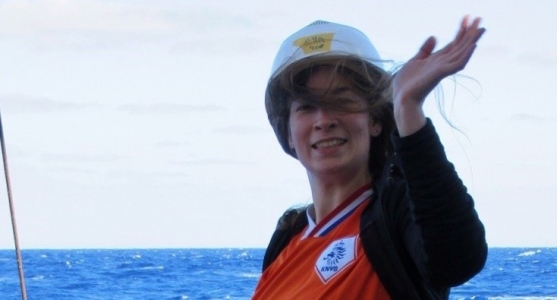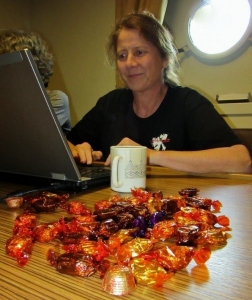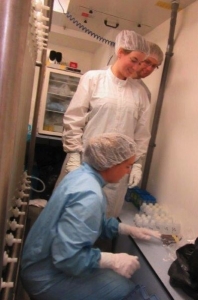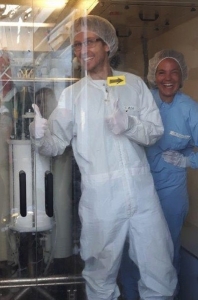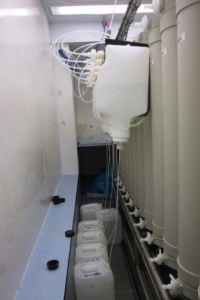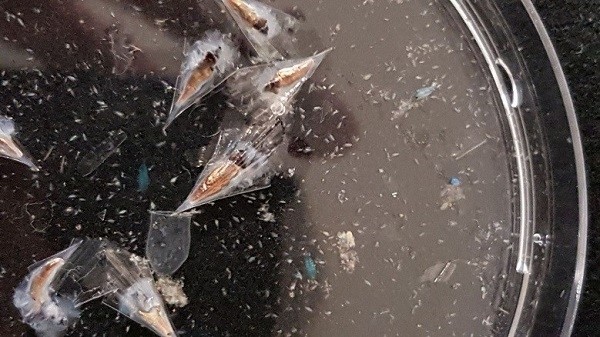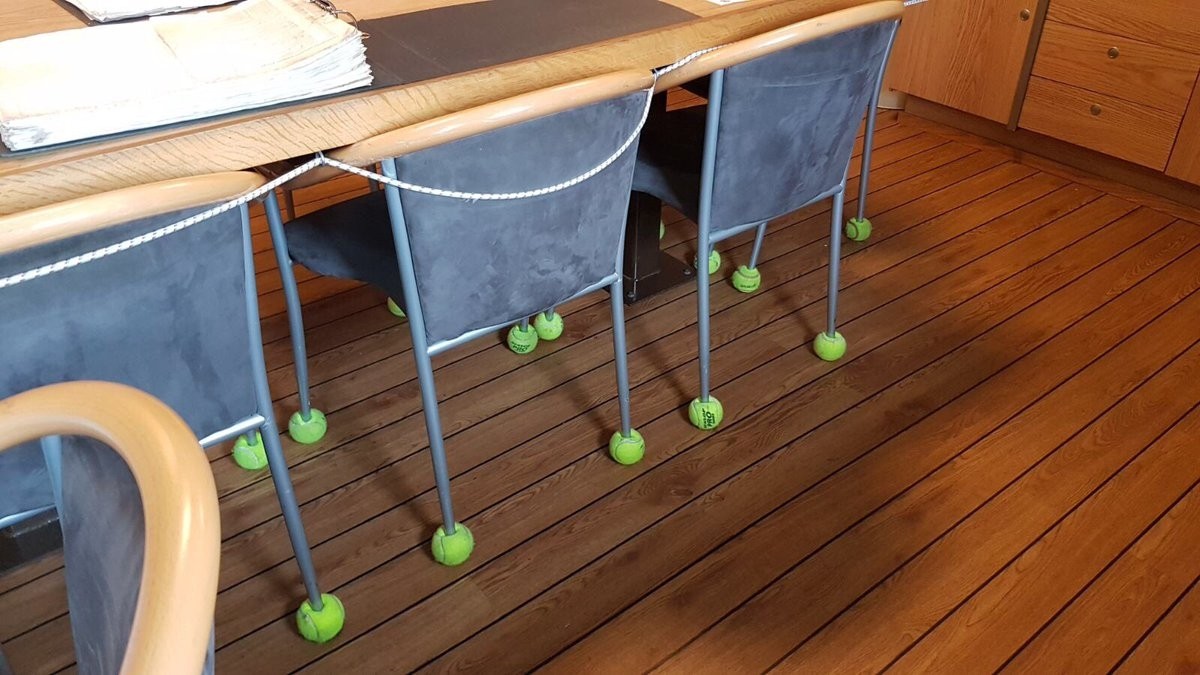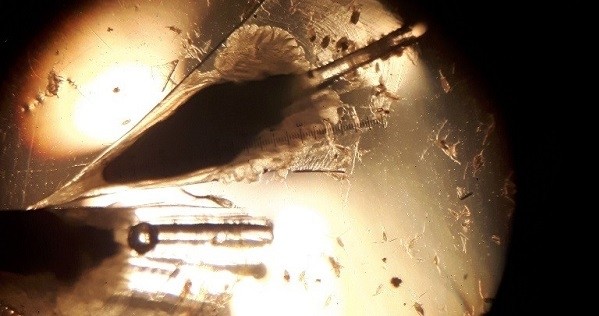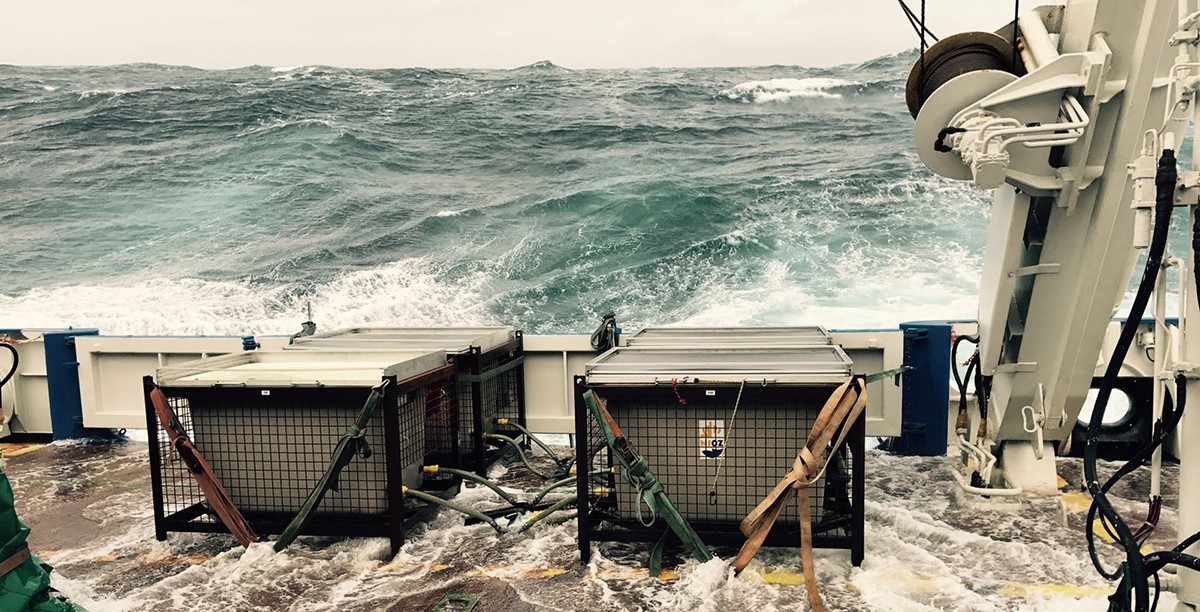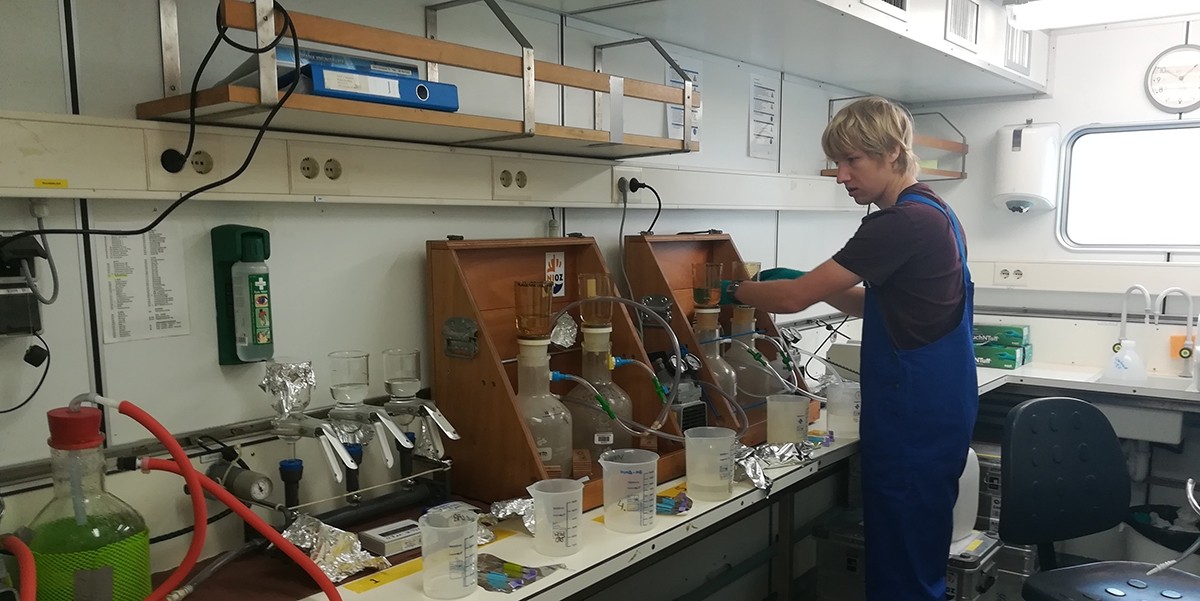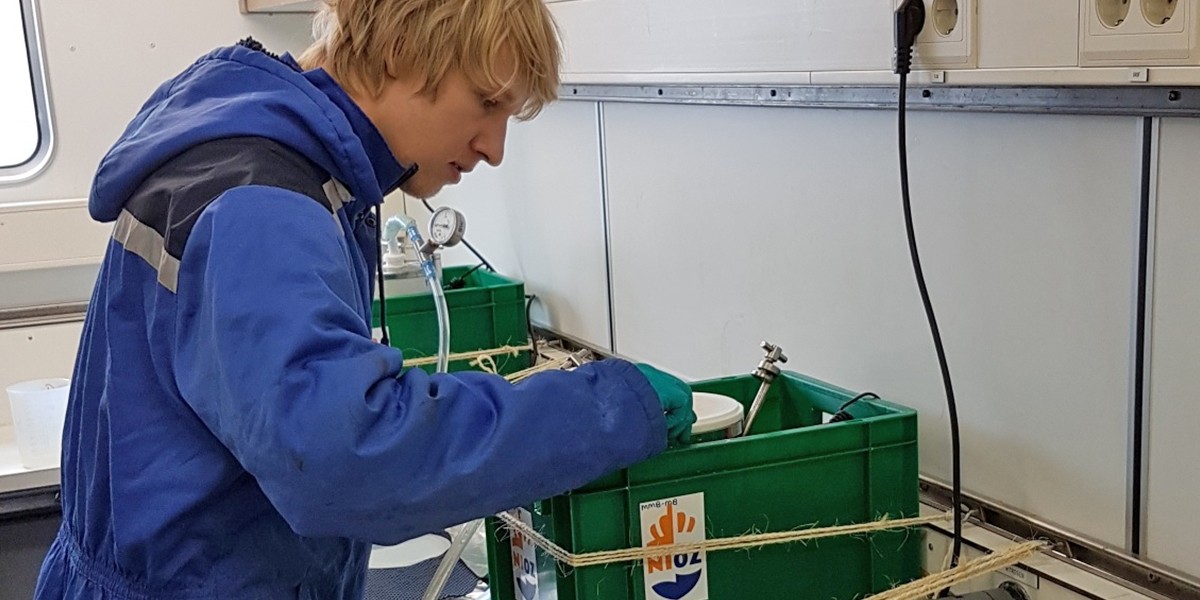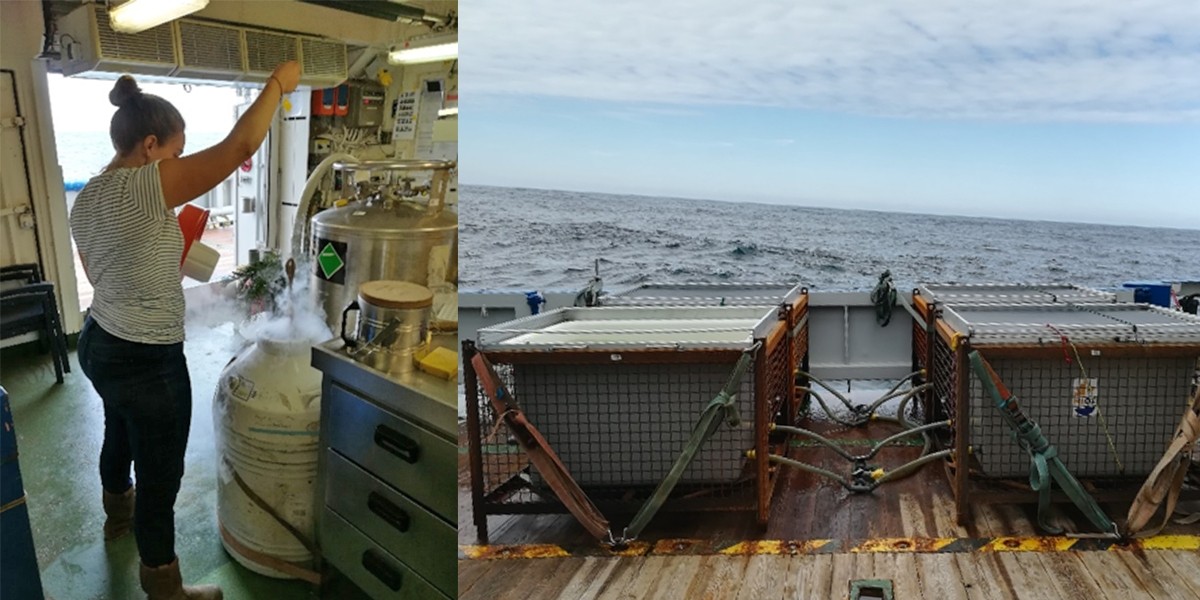Because there was, unexpected, a slot available on short notice and we had a major scientific interest in cruising exactly this time period in the northeast Atlantic Ocean, we were given the green light. Three months later we are at sea, heading towards our first station at approximately 58°N, 17°W. For now we are getting ready for our test station tomorrow, so later more about STRATIPHYT and other research!
~~~The expedition lasts until 17 August. Stay up to date via this blog, Twitter @NIOZatSea or Facebook @NIOZnieuws. ~~~
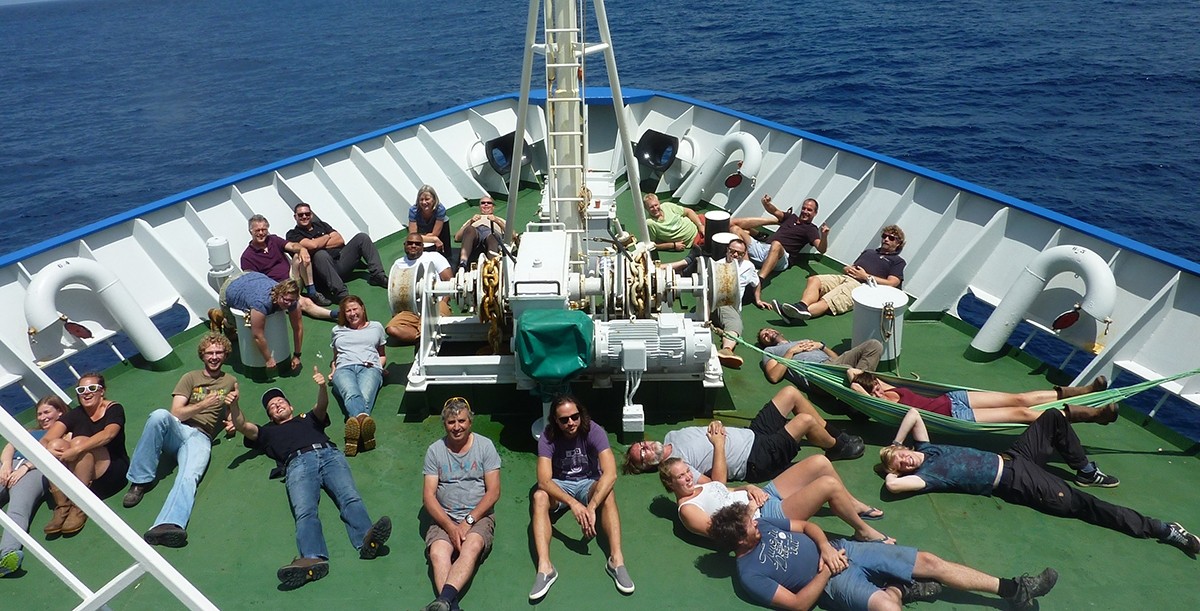
Blog 17 - The end - 'Expedition to the MC to the power of E, i.e. MCE'
STRATIPHYT-17 has come to an end and I am preparing the cruise report, the technical evaluation, the metadata file, and more. While doing so I once more realize that this cruise has evolved around 3 buzzwords: Multidisciplinary, Collaboration and Education. Or in short MEC. Better, after a short talk with Rob we came up with MC to the power of E, i.e. MCE.
And yes, the research does elavate with your career scientists on board. And yes, the different disciplines and input from science and technical staff, through collaboration does make this cruise even more appealing. Especially to the young career scientist I think. That’s how I came up with the question whether “het blik jonge honden” was willing to write a few sentence about their experieces and what they learned from or on this cruise. Below their view. I am happy they helped out so well. I am also happy to see they enjoyed the cruise.
Time to say good bye. Until another time at sea!
Corina (chief scientist)
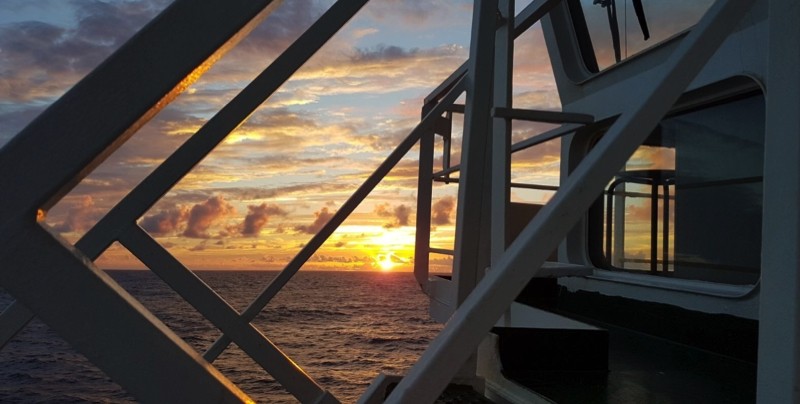
The E-value
Sven Pont
Before enterring the ship I did not have a clue what I was about to experience. A lot has happened in the past four weeks. The most standing out experience was me working in the container with high waves, almost no sleep for two days (due to the waves), sea sick, no orientation point, and still eager to finish the tasks I had. A month ago I did not know I was capable of working while being exhausted and sick combined, and now I know I can! Maybe the limits are even further. This cruise I learned more about science, but I also learned more about myself!
Mathijs van Manen
Measuring dissolved iron (DFe) concentrations on-board with a flow injection system, interpreting depth profiles of DFe, learning about water masses and living and working at sea are a few of the main things I learned during this cruise. Being at sea urges you to think different, problems have to be solved immediately since stations are following each other every single day. In the beginning I needed some days to used to this new mindset but now I can honestly say it is a very useful experience for the upcoming Antarctic expeditions, starting this winter.
Fleur van Crimpen
During the Stratiphyt cruise with the Pelagia I realized there is more to the sea than only the input of dust which I work on for my master thesis. Due to the fact I was lacking knowledge in the microbiological field I had to work hard to keep up with the experiments which were conducted. This process made me realize that flexibility and motivation to learn something new is a key factor here on board. With a topic or research field that is completely unknown, I had to discover it alland I had to give the best I had. Since the cruise with the Pelagia I discovered that the challenge of mastering a complete new field of science gives me energy to learn and grow more.
Tessa de Bruin
Even though my task on the ship was not completely new for me, I gained a lot of experience and better understanding of the biological processes we investigate. I enjoyed the short lectures that were sometimes given by other members of the team which showed how all the science performed on the ship is somehow connected. This journey was also a big help for me deciding whether I would want to do a PhD and, since the answer seems to be yes, what subject and where. It was a good month.
Christine Boschman
This cruise, right at the beginning of my PhD at the NIOZ, was a great educative experience for me. Being on a ship with so many biologists was perfect, because I don’t have much background in biology. Bastiaan could, for example, explain a lot to me about DNA and ‘the central dogma of biology’. By helping several people with their experiments with algae and viruses, and through lectures of Loes, Rob and Corina, I learned a lot about life in the ocean and how stratification and nutrient limitation influence that. I do have a background in sedimentology, but also my sediment experiments were quite educative as I had the change to expand my theoretical knowledge with the knowledge of how different deep sea sediments look, feel and taste like. As my experiments went quite well, I’m excited to analyze the data on the NIOZ when I’m back home!
Bastiaan von Meijenfeldt
Having been out of the field for a couple of years, I have learned once again that generating scientific data can be tough. It turns out as well that my perception of the water column and its biology is rather different when floating atop of it than when sitting in front of a monitor back in Utrecht, a change of views that will surely help me in my research to come. Moreover, I have discovered a before unseen talent of mine, namely balancing 142 mm polycarbonate filters on top of a Teflon filtration tower whilst being machine washed in a lab container. Which is of questionable use to anyone’s career path but nice to know nonetheless.
Ella Wesdorp
The sea never stops to amaze me. It is different every day and it makes me feel at ease even if the ocean itself is not. Working on a scientific research ship has been an amazing experience for me. Even though the work itself can be a bit stressful sometimes, it is great to be surrounded by people who share your interest in science and the oceans. I am grateful that I have had the opportunity to join a research cruise and I am sure this experience will be valuable to me in many ways.
Blog 16 by Corine Brussaard (chief scientist), Ella (student) and special thanks to the crew members Freddy (engineer), Cor (bosun), Bert (chief engineer) & Pieter (captain).
About the Pelagia and more….
By Corina
I have sailed different scientific ship and I have to say that the Pelagia is special; not (only) because it is THE Dutch ship for oceanic research, but also because it is used in a very pragmatic way. The ship is not very long but still holds lots of possibilities to get the science from very different disciplines done in a good manner. Because of its limited size, all space it used to the maximum. A little bigger for the next Dutch ship is thus no luxury, but still I hope we keep the casual atmosphere between scientific participants and crew, the down-to-earth attitude on how to do things, and the endless effort of the crew to help out where needed (and sometimes even before it is needed they anticipate improvements). All ships and crew I worked with so far were good, but Pelagia + crew stays unique.
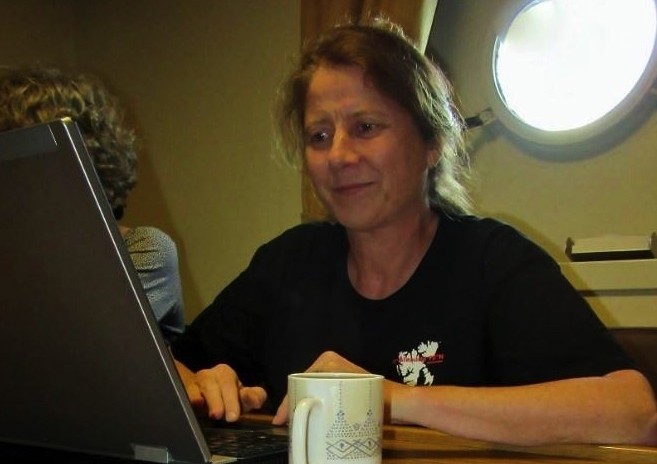
By Cor (bosun)
When l joined the Pelagia there was no internet or Google. The ship was just a few months old and I came here as a ship technician. Since 2012 l am in the function of bosun. Working on the Pelagia was totally different for me. I worked on tugboats, salvage and semisubmersible heavy lift vessels. Four months on and two months off. So the 6 weeks on/off on the Pelagia is much better. The ship was built for the North Sea, but already after 1 year we went to Greenland for sampling in a fjord. Nowadays we are seldom in the North Sea. The contacts between the crew and scientists at sea is direct and unique. That is a plus for the cruise, and l never heard that a cruise is not successful.
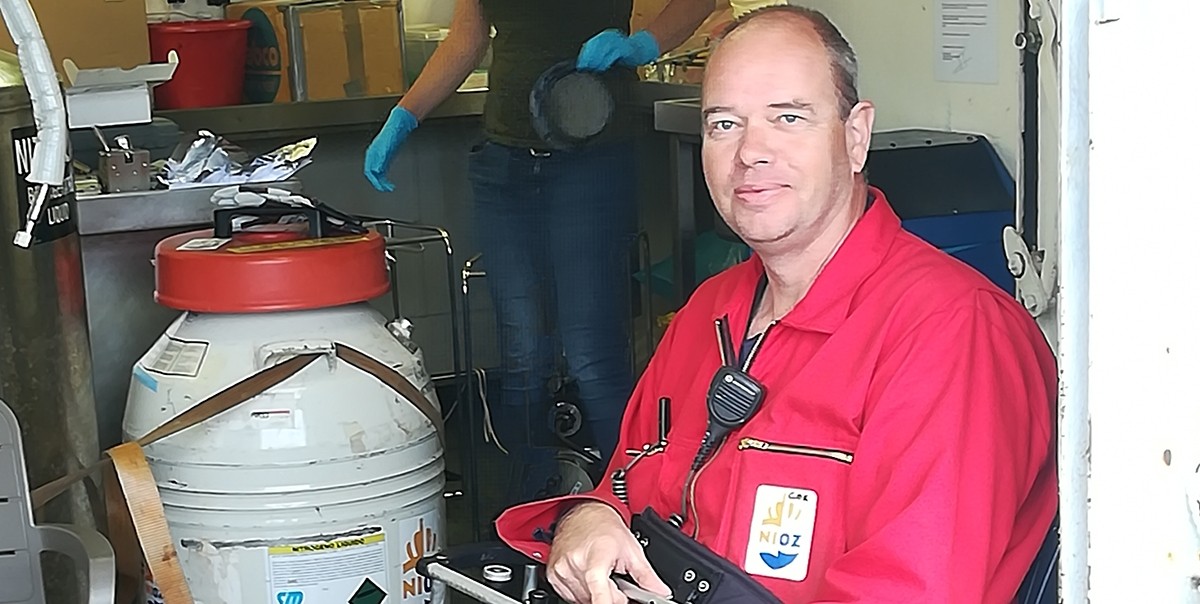
By Freddy (engineer)
Almost 10 years ago that I started working on NIOZ 'flagship' RV Pelagia. I remember like yesterday, after realizing another four years in the school banks wasn't quite for me. Quitted maritime school being an early school leaver as they say, but only after I was told about adult education. I decided to try to achieve my goal walking a different path. I knew what I had to do, apply for a job in the maritime industry at the bottom of the ladder, a job that didn’t require a degree, diploma or what so ever. Suddenly a vacancy showed up, position for steward on a Dutch ocean going research vessel, sailing the oceans surrounding the European and African continent and even to South America! Wow!! I didn’t have a clue what the job was about, but one thing was clear to me - while picturing myself on a Calypso-like ship, surrounded by Jacques Cousteau-like people and environments like I had only seen in Jacques Cousteau's documentary's - THIS WAS AN OPPORTUNITY! So I applied for the job position of steward which was just as unfamiliar for me as it was for Pelagia and her crew at the time. Eventually I got the green light and next thing I knew I embarked the ship 28th of January 2008 on Texel.
I remember being seasick for the first five days and people had their doubts if I would ever get over it. Two weeks later we celebrated my 20th birthday at sea… Almost ten years ago… In this timespan I hopped from steward's position to able seamen (Deckhand) position, still keeping my goal alive getting a diploma someday. Eventually I got the opportunity to get back into the school banks supported by NIOZ. A direction had to be chosen, engine room or bridge. Choice has fallen upon the engine room which by now, serving as 2nd Engineer for a couple of years, I am convinced it was a choice well made.
Looking back, realizing how many great people I have met, places visited, lifetime experiences like being baptized by King Neptune on the Equator, passing the Panama Canal en route to Fiji in the Pacific, Wildlife Safari's, Marine mammals, Volcano's, Glaciers, Waterfalls, meteoric shower, Sea sparkling, and so on… I saw crew members, PhD-students, scientist & technicians come and go, or retiring. Seeing the Ship getting old, it gives me an awkward feeling about closing in on the magic age of 30 myself. Thinking about it makes me realize ten years working on Pelagia substantially made me who I am today and leaves me wondering with loads of questions. Where will I be in another 10 years, what will happen to the Pelagia, will there be a Pelagia 2.0?
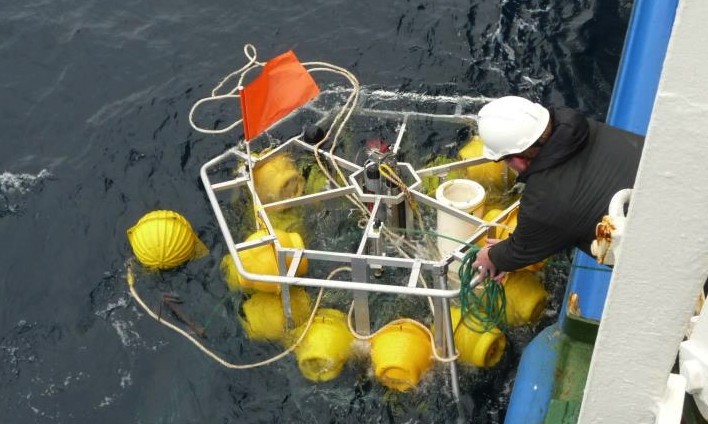
By Bert (Chief engineer)
I am relatively new, working on the Pelagia for 9 months now, and I can say that I like the interaction between the crew and scientist in the professional and social way.
By Pieter (Captain)
Almost 6 years ago, after almost 25 years at sea transporting cargo and dredging, I became one of the captains on the Pelagia. Until now it’s the biggest (public) research vessel of the Netherlands and it happens to be also the smallest vessel I’ve sailed on (as a seaman that is). And a special vessel it is. Instead of transporting paper, steel, bulk, etc., making islands or deepening ports and fairways this ship is dedicated to 'scientific research'.
For us the work on the bridge is not that different. We sail to the positions the chief scientist gave us avoiding all submerged and floating obstacles. Once we arrive at the station we switch to DP-3 (Len, Alle and myself during this trip) to maintain that specfic position so scientific equipment can be lowered. An easy job for me, or as the Dutch say 'a child can do the laundry'. It’s the secondary tasks we have that need some more skills. Like voyage planning to safely (and happily) arrive at the desired stations and until the next port. All this involves making cruise charts, managing the logbooks and instruments, ordering fuel and lubricants (for the engines), but also ordering food & drinks provisions (like 1200 liter mineral water, many eggs, 50 kilogram cheese, coffee for 2000 units, ingredients for 280 liter soup, and lots of the Dutch 'drop').
We organize and perform safety-drills so we are prepared for unexpected events, i.e. there are no fire-brigades at sea and a trip to a shore-based hospital can take more than a week. Furthermore, we do the maintainance on all safety-, navigation-, communication- and other equipment. And last, but not least, we help the scientific crew to solve (minor) problems or answer their questions like: 'How do I connect to the internet/WIFI?', 'Are there any whales/dolphins here?', 'Which star/planet is that?', 'Are you going to chop off its head?', 'Where is the wheel?', 'How high are the waves?', and the most asked one 'Can’t we stop for a swim?'. This is only a very small example of the huge amount and variety of questions a scientist can come up with. Most of the time we have the answers and if not, there's always Google.
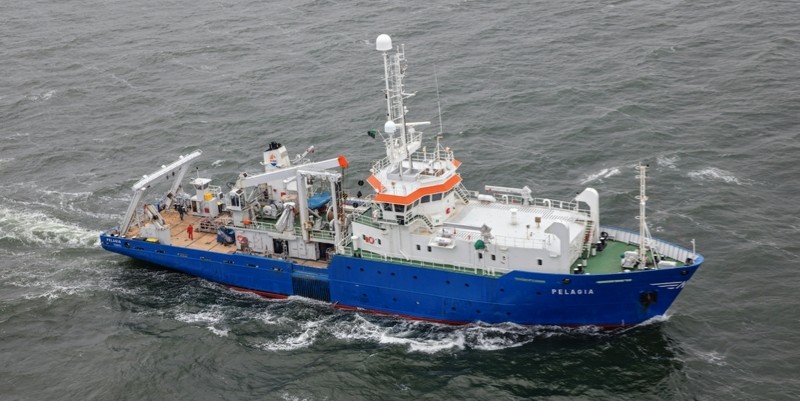
By Ella (student)
Since approximately a year ago the Pelagia serves (whenever possible) only biological meat and fish during their meals. Products such as milk are from biological origin as well. Instead of meat the herbivores (vegetarians) are being served a variety of quite tasty meat-substitutes.
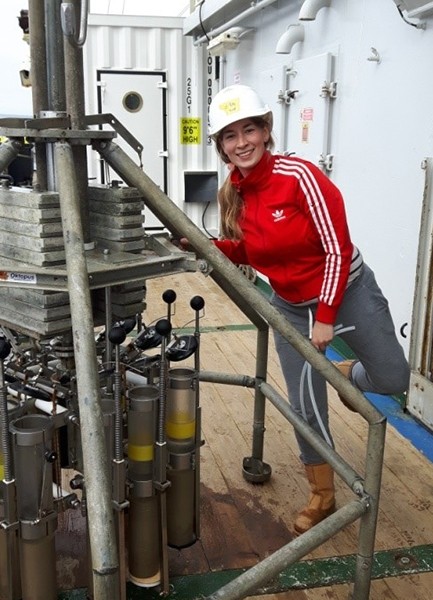
Blog 15, by Ella Wesdorp - Pelagia pubquiz
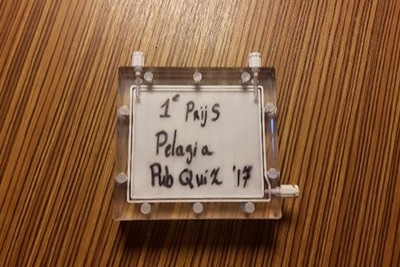
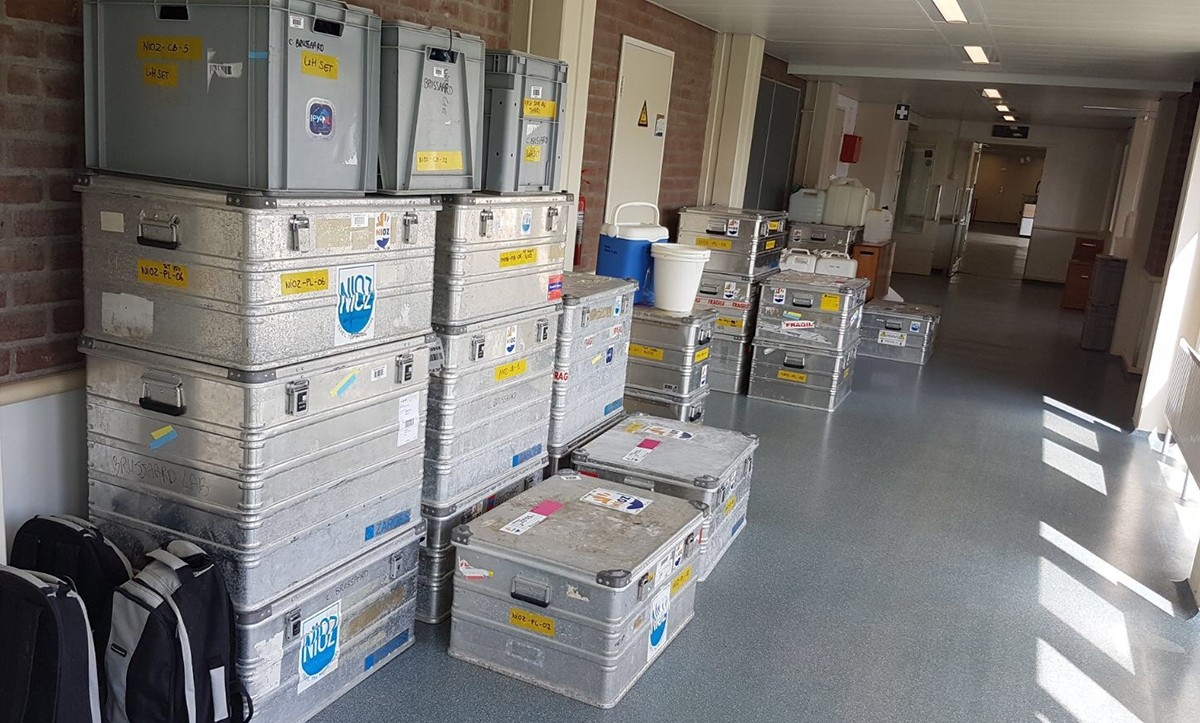
Blog 14 door Mathijs van Manen
Zo'n eerste vaartocht is een zeer bijzondere ervaring op zowel persoonlijk als professioneel vlak. Zo mogelijk alles is nieuw voor mij: het ijzer meten, monsters tappen, monsters verwerken, leven op zee, werken in een zeecontainer (zie de blog van Loes hieronder) en wekenlang niets dan water als uitzicht hebben. Hoe dat bevalt?! Uitstekend!!
Terugkijkend was de eerste week en voornamelijk de eerste stations best hectisch. Doordat alles tegelijk gebeurde schortte het soms aan de nodige organisatie van mijn zijde wat resulteerde in lange dagen en het gevoel in een trein (of schip in dit geval) te zitten die niet meer te stoppen valt. Elke dag een nieuw station betekent ook dat er soms weinig tijd is achterstallig werk in te halen. Zo leerde ik dat slangetjes van het flow injection systeem goed aansluiten en alle chemicaliën goed schudden van onschatbaar belang zijn wil je goede data verkrijgen. Nu klinkt dit alles erg logisch maar kan ik vermelden dat dingen op zee toch net even anders werken als op het vaste land, de beste stuurlui staan niet voor niks aan wal. Na enige oefening en een wat georganiseerdere aanpak begon alles vrij vlot te lopen en kregen we al snel mooie ijzerdata, zijn we interessante interessante bioassays aan het uitvoeren, tapt het tapteam (Rob, Fleur en ik) als een geoliede (metaalvrije) machine en vliegen, of eigenlijk stomen, de weken voorbij.
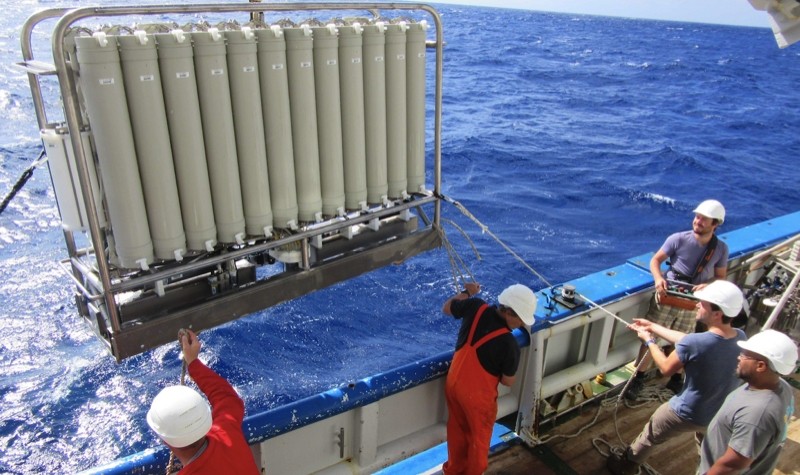
De laatste dagen oefen ik mee om het ultracleane-CTD apparaat (dat onze watermonsters neemt) uit het water te vissen omdat we op de Antarctische Oceaan cruise straks (komende december) geen geweldige bemanning hebben die dat voor ons doet (zie foto). Zo is deze cruise dus ook een perfecte en nuttige ervaring voor wat komen gaat. Jullie hebben al kunnen lezen dat er naast de wetenschap uiteraard nog meer dingen gaande zijn aan boord en zo was het ook gisteravond weer raak! Na drieënhalve week en vele uren werk kregen wel een weergaloos natuurfenomeen voorgeschoteld.
De jaarlijkse meteorietenzwerm Perseïden komt op dit moment langs de aarde en sommigen van ons hebben het voorrecht gehad dit vanaf een nagenoeg donker schip te mogen aanschouwen. Nu is een sterrenhemel waar de melkweg duidelijk te zien is al iets fantastisch, maar met een enorme hoeveelheid vallende vuurbollen is het werkelijk iets unieks! Verspreid over het dek stonden we te kijken en hoorde je zo nu en dan flinke vreugdekreten (waarnaar je overigens altijd te laat bent het zelf nog te spotten..) als er weer een vallende ster gespot werd. Omdat al het goede altijd in overvloed komt besloot ook de zeevonk vrolijk mee te doen en konden we ook dit spektakel aan de boeg aanschouwen!
Nu hebben we nog een paar stations te gaan en nog een genoeg uit te werken en op te ruimen voordat we Tenerife binnen varen. En hoewel we er nog niet zijn kan ik alvast melden dat ik enorm uitkijk naar de uitkomst van deze tocht en nog gemotiveerder voor de volgende!
Blog 13, door Loes Gerringa - Mijn dagen in een zeecontainer
Om half zeven gaat de wekker en ik spoed mij voor het ontbijt naar container 28, waar ik meestal Mathijs al tref. Mathijs staat zijn analyse apparatuur bezwerend toe te spreken om zich te gedragen deze nieuwe dag. Voor het ontbijt moet ik iets inzetten dat 1 uur in evenwicht moet komen en dat gebeurt tijdens het douchen en ontbijten.
Tussen ontbijt en lunch en tussen lunch en avondeten wordt mijn tijd gedomineerd door de timer. Elke 12 minuten moet ik een meting starten. Dit betreft een voor mij nieuwe analyse om ijzer-bindende liganden te meten. Deze liganden zijn organische stoffen in het zeewater, die ijzer binden en er zo voor zorgen dat het ijzer in oplossing blijft en niet verdwijnt als een oxide of roest deeltje. Dat is essentieel want algen hebben ijzer nodig, zonder ijzer geen algen. Deze zo geheten liganden zijn belangrijk, maar we weten er nog niet zoveel over. Een extra (voor mij) nieuwe meting bezorgt me heel wat hoofdbrekens. Zo heb ik gemerkt dat de reactie die ik gebruik niet in evenwicht is, dus verandert met de tijd, wat eigenlijk niet zou moeten. Om reproduceerbaarheid te benaderen, meet ik nu via een strak tijdschema, waardoor elke meting in ieder geval exact dezelfde reactie tijd heeft gehad.
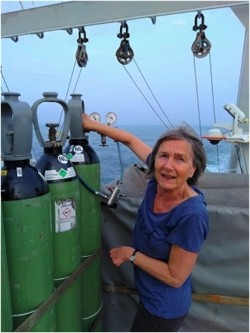 Kortom mijn tijd wordt gedicteerd door de timer en mijn dagen beleef ik dus in zeecontainer 28. Ik geef toe dat dit rust, reinheid en regelmaat biedt. Het is een 'clean' container met gezuiverde lucht en laminaire flowkasten, maar het geeft ook een grote voorspelbaarheid. Hier hebben ze wat op gevonden. Op gezette tijden moet ik naar een stikstof gasfles om de toevoer te openen of dicht te draaien.
Kortom mijn tijd wordt gedicteerd door de timer en mijn dagen beleef ik dus in zeecontainer 28. Ik geef toe dat dit rust, reinheid en regelmaat biedt. Het is een 'clean' container met gezuiverde lucht en laminaire flowkasten, maar het geeft ook een grote voorspelbaarheid. Hier hebben ze wat op gevonden. Op gezette tijden moet ik naar een stikstof gasfles om de toevoer te openen of dicht te draaien.
Deze fles staat achter op het B-dek. De bemanning Cor, Norberto, Patrick en Bas hebben net het dek geverfd en een alternatieve route voor me bedacht. Norberto begeleidde me om ongelukken te voorkomen. Eerst moest er een trap naar een hijskraan beklommen worden, hierna overstappen op een containerdak, over een reling naar een tweede containerdak en via een reling naar de gasfles, drie keer per dag heen en weer geeft een enorme afleiding. Helaas is de verf inmiddels gedroogd.
Gelukkig wordt in container 28 ook ijzer gemeten door Mathijs. Behalve goed gezelschap zorgt Mathijs ook voor veel afleiding. Hij brengt nieuwtjes over het leven buiten container 28. Hij sleept met honderden flessen en flesjes de container in en uit; flessen die allemaal een nummer moeten krijgen, voor ze (elders) gevuld worden. Hij liet zien hoe versleten onze emmer is, toen die vol water midden in de container finaal doormidden scheurde. En last but not least, we wisselen wederwaardigheden uit over de nukken van onze apparaten en beleven daar veel steun aan.
Mijn oude methode doet het goed, ik weet echter nog niet of ik van boord ga met ook mooie getallen van de nieuwe methode; hiervoor zijn nog wat dagen in container 28 nodig.
Blog 12 by Bastiaan von Meijenfeldt, PhD-student Utrecht University
# August 9, 2017
The track we sail covers two very distinct regions of the North Atlantic, bridged by a leg that we call Transect (there's a slight hint of confusion there, since, surely, the entire cruise is a transect as well. Let's think about it as the unnamed subset). The two regions are simply called North and South, yet beneath the obvious naming they differ like day and night. Name it, they differ; biology, chemistry, weather. For now, I want to turn my attention to that last one, the weather (and its bigger brother climate), since in lots of ways processes in the water column that we look at are very much connected to, and forced by, processes in the atmosphere. During STRATIPHYT-17, this couldn't be much clearer.
Some time ago (days, weeks? - the first thing I lost at sea is the perception of time; it's always Wednesday here for me), I wrote about doing science in heavy weather. This wasn't a coincidence of course, since we roamed the North.
## The North
Look at an average weather map of Western Europe (you can Google 'Bracknell weather charts'), and you will find that not only will it include a large portion of the North Atlantic, but also the northern part of the map's covered with 'L's. These are the infamous low pressure areas, or depressions. They arise at latitudes near Iceland, at a region called the polar front, where warm air from the south meets cold air from the north. Being areas of low pressure, they pull in air from their surrounding (which we tend to call wind), and Earth's rotation gives the entire system a counterclockwise spin on the northern hemisphere. The result is not only rotation, but also a standoff between cold and warm air, the battlegrounds of which are depicted by the lines with balls, triangles, or both, on the weather map ('front', is the official name). The battle is visualised in clouds; extended horizontal layers where warm pushes cold, high towering where cold pushes warm.
It can be explosive, conditions can change rapidly, and there can be (lots of) rain. This is the recipe for the frontal depression. We know them very well, since all the 'L's you're looking at, will, surely and steadily, move to the east, following the path of the Gulf Stream and the North Atlantic Drift, to rain down on the Netherlands (which is why the weather map of Western Europe covers so much ocean, and also why you can complain about Dutch weather).
Or to test a ship south of Iceland. Luckily, rain isn't much of an issue here, but did we see wind. Since we're south of the low pressure cores, there's always a western component in its direction (remember the counterclockwise rotation of the system), which explains why getting sleep there while on a North-South tack is near impossible. And why I downed sea sickness pills like Smarties during these days. All this wind shear, constantly changing conditions, rain; it is reflected in the water column. Every now and then, the top layer is thoroughly (deeply) mixed, and every depth signal vanishes. Extended periods of rain turn the water significantly fresher. During summer (while we are there) there is vertical stratification with warmer water (all is relative) in the mixed top layer. Strong winds like we experienced did not last long enough to mix deeper. Good for us!
## The South
The South though, that's a different story. At the Horse latitudes (30°N), high pressure is king. The Azores High's reign is stable; look at the map again and you'll find it without exception; the 'H' in between Southern Europe and North America. Air encircles it clockwise, always stable, very predictable. There are not many of fronts here, if any. West of Portugal, the northern winds push us towards our destination, waves in the back. If we happen to miss Tenerife, the easterly Tradewinds will take us to the New World, the same ones that guided Christopher Columbus. Clouds disappear in the sinking air of high pressure areas, sun is the norm. And again, very stable. The top of the water column knows; everyday's the same, a variation on the same theme. Limited rainfall, so the salinity is high. Mixing extends roughly to the same depth at every station.
## The Transect
Right before we enter the South, at the Transect, I tell the crew an extended version of this story, show some weather maps, and do an easy prediction; high pressure weather. Wind 20 knots from the North. Sure enough, everybody thinks there's big time summer ahead. Stupid me.
The next day, it's high pressure weather alright. The sun is shining, a steady 20 knots is blowing from the North. Yet I see a lot of angry faces, because apparently I forgot to mention that those very stable winds can build up some very nasty waves. It turns out people don't associate summer with being tossed around in a sea container. Consensus for some is that my predictions were all wrong. Note to self: predicting the weather's not always rewarding.
Luckily we got the wind in the back whilst sailing, so at least I get a good night sleep, all the way to Tenerife. Maybe in a few days I dare another prediction: high pressure weather; sun, wind from the North, chance of waves.
Footnote: If you want to follow the current weather and predictions for the RV Pelagia, www.windy.com has some nice and accessible visualisations (put them next to the Bracknell charts). Don't forget to set prediction model to ECMWF as opposed to GFS.
P.S by Corina: due to technical failure of one of the lab containers we lost an important experiment that runs for 24h; so the next day (i.e. next station) it was decided that we sail back and redo the experiment. This means sailing against these steady winds; up and down, up and down….
Blog 11 by Kirsten Kooijman, Anna Noordeloos & Loes Gerringa - STRATIPHYT-17 ABC
A
De A staat voor alg. Algen worden op deze vaartocht op verschillende manieren ‘verzameld’. Ze worden over een filter heen gehaald om te kijken wat voor pigmenten ze bevatten (door Kirsten). Ze worden gemeten door Anna op de flowcytometer om de aantallen te bepalen. Ook meten we 'het geluk van de algen' oftwel hun fotosynthetische capaciteit.
B
De B staat voor Boot, waar alles gebeurt. Een kleine greep uit het assortiment B: Bruiningsschema nu we eindelijk zon hebben; tussen de metingen door even op de uitkijk staan om Bruinvissen te spotten; en niet te vergeten de liters Bleek die er doorheen gaan om speciale filters te ontdoen van algen materiaal. Ooh en het handige is, Bacteriën gaan er ook dood van.
C
De C staat voor CTD; Conductivity Temperature Density. Het is een instrument dat dagelijks meerdere malen overboord wordt gehezen om vervolgens af te zakken naar de diepte van de zee, variërend van 500 tot 5000 meter onder toeziend oog van Ruud. De CTD meet continu verschillende parameters, zoals temperatuur, diepte, hoeveelheid licht, fluorescentie, zuurstof en zoutgehalte.
D
De D staat voor DCM. DCM betekent Deep Chlorophyll Maximum. Zo’n laag bevindt zich op een diepte waar nog net genoeg licht is voor fotosynthese, maar waar de concentratie voedingszouten (zoals stikstof en fosfaat) in wat hogere concentraties aanwezig zijn dan in de bovenste waterlaag (daar zijn de concentraties van deze nutriënten heel laag).
E
De E staat voor Eten. Eten aan boord is een belangrijke gebeurtenis en daarin worden we Excellent voorzien door Leon! Zo kunnen wij goed functioneren om alle Experimenten aan boord uit te voeren.
F
De F staat voor Filtreren. Dat doen wij hier veel. We filtreren over filters van verschillende maten, materialen en poriegroottes. Sommige filters raken snel verstopt en andere kunnen heel wat hebben. Na het filtreren bevriezen we de filters soms in vloeibare stikstof (snap-Freeze) of anders bij -80 graden. Analyse gebeurt als we terug zijn op het NIOZ.
G
De G staat voor Groene flits, maar ‘zo flitsend’ is het hier nog niet geweest. Maar Grienden waren er in Grote Getale een keer vlakbij het schip. En we hebben een flitsende Groep onderzoekers natuurlijk.
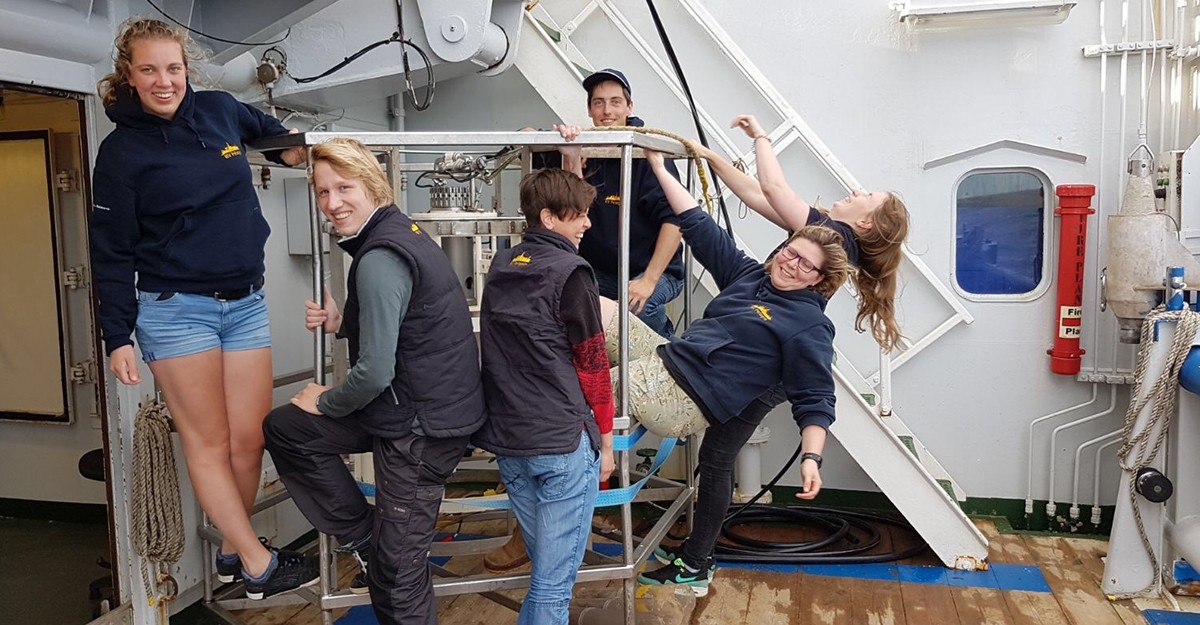
H
De H staat voor Hogedrukgebied, waar Bastiaan als amateur meteoroloog boeiend over kan vertellen.
I
De I staat voor Improvisatie. Wetenschap vraagt veel flexibiliteit en Inzet, van de meegebrachte Instrumenten en van Iedereen. Iedereen helpt Iedereen waar nodig. En de assistenten staan garant voor het de snelle uitgave van alle Items (spullen; bijv. pipetpunten, scharen, flessen) die nodig zijn. Ze nemen ook gehele Incubatie experimenten over tijdens een stormachtige dag op zee (waardoor niet Iedereen meer werkte).
J
De J staat voor Jonge honden, die dartelen over het dek. Tessa, Sven, Bastiaan en Mathijs klauteren vaak naar de vogeluitkijk op de stuurhut. Ella is op jacht naar plastic en brengt zo ook de mooiste mini-wezens onder de microscoop. Fleur weet zelfs het taaie ‘monsters-tappen’ op te fleuren door haar opgewekte humeur en Christine gaat de diepte in, zij wil tot op de bodem!
K
De K staat voor Kapitein, de gezagvoerder en daarmee de eindverantwoordelijke aan boord. Wij zeggen gewoon Pieter en bezoeken hem met plezier op de brug.
L
De L staat voor Lagedrukgebied, die hebben we achter ons gelaten, of was het boven ons. Maar L staat ook voor Liganden, waar Loes naarstig naar speurt (meten doet ze op de klok met timer in de hand).
M
De M staat voor Mixed layer, en voor Matroos. Beide zijn onontbeerlijk voor het slagen van ons doel. Corina gaat hiervoor door het vuur.
N
De N staat voor Nederland-Denemarken, schor zijn we!
O
De O staat voor Ontbijt, waar de kok Leon (oh oh, Leon hoort eigenlijk bij de L) klaarstaat om een eitje te bakken of hij is al bezig met voorbereidingen voor de Lunch (zucht….weer een L...).
P
De P staat voor Pelagia. Pelagia is de naam ons schip. Met de Pelagia varen we van Noord naar Zuid. Er gaan niet alleen CTD's, multicores en pompen overboord, maar ook een sleepnet voor micro-Plastics onderzoek. Plastic Particles (deeltjes) die oorspronkelijk van land komen drijven in de oceaan. Ze geven een eerder niet bestaande Plek aan organismen om zich te verplaasten, en vormen mogelijk een bedreiging voor leven in zee.
Q
De Q staat voor Quality Street chocolaatjes, een belangrijke 'voedingstof', die nu bijna op zijn.
R
De R staat voor Rust Roest. Dat doet de Pelagia niet, wij meten ijzer-vrij en wij hebben geen tijd om te Roesten.
S
De S staat voor STRATIPHYT en Stratificatie; de geStratificeerde (gelaagde) waterkolom maakt ons blij, daaraan willen we meten en bemonsteren.
T
De T staat voor Turbulentie, maar staat ook voor TEP (Transparant exopolymer particles) en Taart. Zou die Turbulentie wat doen met die TEP? Taart hadden we tot nu toe twee keer, voor Anna en Norberto.
U
De U staat voor Ultra-Clean CTD, door Leon en bemanning te water gelaten en waar Rob de scepter over zwaait. Uren verdwijnt hij samen met Matthijs en Fleur in een speciale container om liters en liters en liters water te tappen en filtreren.
V
De V staat voor Vertier, wat wij vinden in wandelingen over het schip, de dolfijnen voor aan de boeg, darten in de mess en een uurtje aan de bar.
W
De W staat voor Winkelen. Winkelen hoeft Kirsten niet, 4 weken lang niet. De kok heeft al het eten al gehaald. Gelukkig heeft de Pelagia een collectie merchandise en kan ze hier een complete winter- en zomer-garderobe aanschaffen; alles voorzien van een mooi geborduurd logo van het prachtige schip waar we op varen. Kirsten staat al te popelen om te shoppen tijdens een toekomstige cruise als de nieuwe collectie er is.
X
X staat voor de vele kruisjes op de CTD taplijsten. Corina maakt die bij elke CTD zodat iedereen die zeewater nodig heeft weet van welke CTD-bemonsteringsfles en en van welke diepte het komt.
IJ
IJ is van IJzer, zo schaars en zo snel in de monsters als contaminant. Maar daar hebben we geen last van door de Ultra clean ctd!
Z
Z is van cola Zero, een erg populair drankje op het schip. Maar natuurlijk is de Z ok van Zee, oneindig en mysterieus, we proberen haar te begrijpen, maar staan aan het begin. Z is ook van Zuivel, die is inmiddels niet meer vers.
Blog 10 by Christine Boschman, PhD-student University Utrecht - Exploring the ocean floor
The ocean is fascinating. While being on board of this cruise, questions are constantly popping up in my head. Some questions can be answered easily and some are unknown to everyone. When I wonder why on sea we use nautical miles and knots instead of kilometres and kilometres per hour, the chief officer explains to me that the nautical mile is the length of one minute of longitude along the equator, and knots are nautical miles per hour. When I wonder why the main wind direction has changed, Bastiaan explains about westerlies and trade winds. When I wonder about the biology or chemistry of the ocean, the other scientists here have great answers to almost everything I ask. But one question that is circling through my head remains unanswered, which is how the large differences in depth of the ocean are caused.
Almost every day, the multicorer goes down to the ocean floor to pick up sediments. Sometimes this takes an hour and sometimes three hours, which depends on the depth of the ocean, as the multicorer has to travel all the way through the water column. At some places we have been, the ocean was 1200 m deep, and where we are today it is 5300 m deep! As I have a background in geology, I had hoped to be able to explain how these large differences are caused, but I must admit that I don’t understand it. On land, I understand how mountains are formed because of plate tectonics, and how valleys are formed because of erosion. But how does that work under water? I think it is especially fascinating because the differences are so large. Some large scale differences I do understand, like how volcanic activity at the Mid Atlantic Ridge causes under water mountains and therefore a shallow ocean. Also, I know that the farther from the ridge you get, the older and therefore heavier the oceanic crust is, causing the ocean to be deeper as the oceanic crust sinks deeper into the mantle. But there are a lot of altitude differences which cannot be easily explained by these features. Can plate tectonics cause altitude differences of several kilometres far from plate boundaries? Or can under water currents cause huge valleys because of erosion?
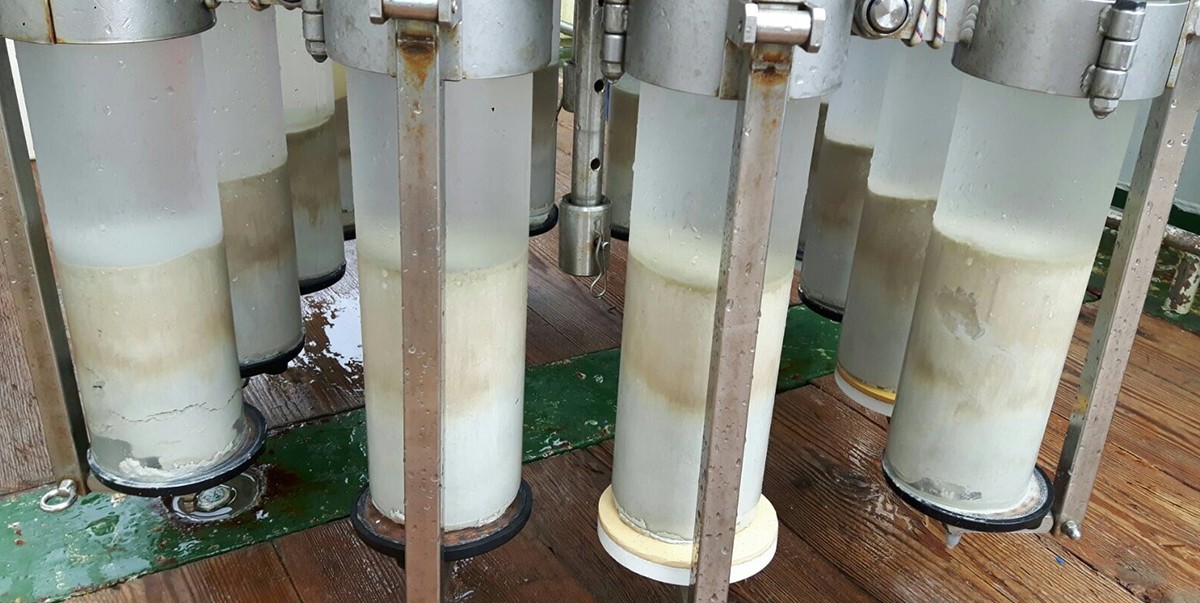
The sediments we pick up with the multicorer can give us insight in some things that happen at the bottom of the sea. Later, at the NIOZ, we will look at organic compounds like lipids in the sediment, but right now we are already looking at colour and grain size and other remarkable features. Colour and grain size can tell us something about the environment of deposition. Other things we notice are for example tilted sediment surfaces, air bubbles or worms. Do tilted sediment surfaces mean that the ocean floor was not flat? Or did the multicorer move while hitting the floor because of water currents? Most of the sediment we find is clayish, but one time it was very sandy. We were at a location with a depth of ~2800 m, close to the Rockall plateau (west of Ireland), which is ~1200 m deep. I could imagine strong currents flowing from the plateau towards the deeper ocean, like landslides under water. In such a disturbed environment, light clay particles do not settle, only sand is heavy enough to sink to the bottom. Today, at a very deep location, we found very fine grained sediment, probably because of a quiet environment. Also, the sediment was darker coloured which indicates more organic matter. This is my favourite sediment so far, because it will contain a lot of interesting organic compounds, but also because you can make nice sculptures with it.
As we are at such a deep location today, we did another small experiment, just for fun. We are fascinated by the huge water column beneath us, and to see how much pressure the water column gives, we send some small (and nicely painted) pepper foam balls down with the multicorer. They came back a lot smaller! When seeing this, I think it is pretty clever of the worms I sometimes find in the sediments that they can live under such large pressures. The poor animals must have had a huge shock being brought to the surface were the water pressure is gone.
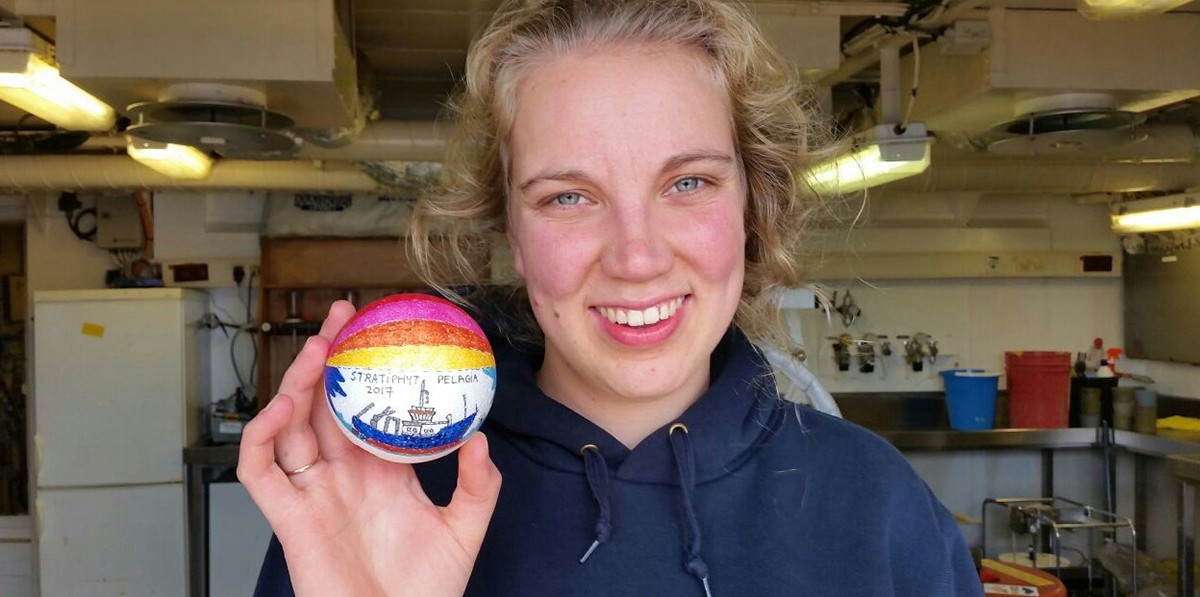
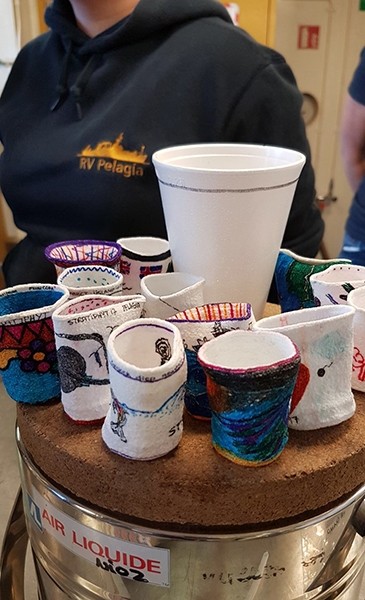
Blog 9, Rob Middag, NIOZ -
Nutritious metals
When one thinks about the oceans, metals are probably not what springs to mind, yet metals play important roles in marine cycles. Though often regarded as toxins, metals are required as nutrients for the growth of all organisms. Metals form the reactive centres of enzymes, enabling these to perform biochemical functions, such as oxygen-transport or photosynthesis. As such, trace metals are central to the health of individual organisms as well as entire ecosystems. In the open ocean, the base of the food web is formed by unicellular algae, known as phytoplankton. For certain ocean regions, trace metals, notably iron, can limit the amount of phytoplankton that can grow, and thus the amount of life that can be sustained. Since phytoplankton take up CO2 from the atmosphere, trace metals influence atmospheric CO2 levels and global climate. However, only limited knowledge exists about these algae-trace metal interactions and their susceptibility to a changing climate.
Mixing by wind and waves
Metals can reach the open ocean through deposition of atmospheric dust that gets transported through the atmosphere from arid regions such as the Sahara desert. During the Stratiphyt-17 cruise we visit two contrasting biogeochemical regimes where the northern region is characterized by relatively low dust loading and deep mixed layers whereas the southern region has a relatively high dust loading and shallow mixed layers. The amount of mixing by wind and waves also affects the trace metal concentrations as the concentrations of bio-essential metals are elevated in the deep ocean due to the remineralisation of dead biological material that sinks from the surface ocean.
Deep Iceland basin gateway of bio-essential metals?
We test if there is iron limitation of phytoplankton growth using bio-assays in the northern and southern region. In these experiments we take water from the surface ocean and incubate the phytoplankton population with and without supplemented iron to see if there is an effect of iron. Additionally, we take samples to assess the distributions of metals and some metals isotopes over the water column to gain insight in the sources, sinks and cycling of these metals. The concentrations of iron are determined shipboard, but we take many more samples back to NIOZ for analysis in the trace metal lab. This will give us information on the concentrations of metals in the dissolved form as well as in particles. The latter comprise both living cells as well as dead matter. With the use of isotopes we will also be able to look into the origin of the metals, i.e. where they came from.
Based on our shipboard analysis of iron we already saw interesting high concentrations in the deep Iceland Basin. This ocean region is a gateway between the Atlantic Ocean and the northern and Arctic seas. It would seem that essential metals get transported from the high north into the deep Atlantic Ocean and we will need to investigate further to determine if these metals eventually make it to the surface ocean where they can be taken up by phytoplankton.
Video, starring ultra-clean TITAN taking a dive for iron traces - essential for photosynthesis, atmospheric CO2, global climate...life, basically.
About Titan, the ‘ultra-clean’ sampling system for trace metals and biology: Because trace metals occur at vanishingly low concentrations, traditional sampling systems cannot be used as the metal in these systems or the cable it hangs from, would contaminate the samples. This system is deployed on a Kevlar cable and is made out of titanium and plastics, allowing us to collect uncontaminated samples. The samplers (called tubes or bottles) used to be transparent white, but for the biologists this was not enough. To prevent sudden exposure to different light intensities when brought to the surface and on deck, we use now these greyish tubes. The entire sampling system is parked inside a clean-air container. The air inside of this container is filtered to keep the environment free of dust and other contamination and we dress up in dust-free clean room suits when collecting our samples from the Titan system.
Blog 8, by Ella Wesdorp, Msc student Marine Sciences Utrecht University
Microbes colonizing microplastics
During this cruise we focus on microbes, as they are the most abundant life form in our oceans and very important in terms of ecology and climate change. Most microbes live as free-living organisms (planktonic), but they can also grow on substrates. Recently a new substrate has been discovered; microplastics. Plastic pollution of the oceans forms an ecological problem. Luckily this has gained increased awareness over the last years. We know most about the effect of plastics on large animals. Not much is known about the effects of microplastics on small organisms. Besides and quite important: microplastics in the oceans form a completely new substrate in the history of Earth. During the STRATIPHYT-17 cruise we also sample for microplastics floating on the ocean’s surface. We are interested in which microbes actually colonize these plastic substrates. Molecular analysis will be performed in collaboration with a new NIOZ colleague (Linda Amaral-Zettler).
Shiny umbrella-like sea-snails
During the first days of sampling (south of Iceland) we found mainly algae and some zooplankton (small predators; copepods), although also one day a lot of blue surface-living copepods. But also some small pieces of plastics. After the storm there was a lot of dead material floating at the surface and no microplastics were found. A couple of days later, we caught many copepods, and also these amazing, pyramid-shaped, sea-snails. To me they looked like little shiny umbrellas. The sea snails were not the only amazing animals we encountered on our trip so far. A large group of long-finned pilot whales was hanging around the ship at our first station (see second blog). And this morning a group of common dolphins joined us on our journey to the south.
Blog 7 by Corina Brussaard (chief scientist), NIOZ
STRATIPHYT-17, the name of the current cruise. Yes, the number 17 means the year 2017, but also it indicates to 2 earlier cruises done within the former project STRATIPHYT. This project was all about understanding how unicellular algae (phytoplankton) in the northeastern Atlantic Oceans may be affected by global climate change. This oceanic region is sensitive to global warming and as such is likely to experience that the surface waters of the ocean will warm faster and earlier than before. This warmer water will stabilize the water column (i.e. strengthen vertical stratification) and consequently the depth to which mixing occurs is reduced. This in turn will make the phytoplankton dependent on recycling of essential macro-nutrients such as nitrogen and phosphorus. Normally new supplies from the deep are brought to the surface through mixing and so - with reduced mixing - the supply reduces.
The project constisted of different partners, with expertise in physics, phytoplankton primary production and community structure, phytoplankton mortality, and modelling. The project ran for 4 years and the part on phytoplankton mortality was my expertise. A PhD-student showed amongst others that all the different phytoplankton groups were prone to viral infection. Traditionally, cells were mainly lost through grazing (being eaten) and death from viral infection was not considered. Nowadays we know that viruses in the oceans play a key role in biodiversity (since they are selective who they infect) and also the cycling of elements such as carbon, nitrogen and phosphorus. The reason is that majority of all living biomass in the oceans consists of the very small-sized organisms. That means that only about 5% of the living biomass can be seen with the naked eye, the rest is microscopically small. Phytoplankton belong to these microorganisms. And since they are only 1 cell large (or small J) they are likely to be rapidly killed upon viral infection.
Until recently, there were only few measurements of the actual death rate of phytoplankton by viral infection published. This is because it is not easy to measure specifically the death rate of the algal cells due to viral action. During the earlier project STRATIPHYT we were thus very happy with the many data we obtained on viral lysis rate (i.e. death rate from viral infection). We compared those with the grazing rates and noted that viral lysis is as an important loss factor for algal cells than grazing. Since we wanted to know how global climate change may affect the share of these 2 mortality factors, the cruise track included oceanic region with year-round vertical stratification as well as a northern region with seasonal vertical stratification. We found no differences in the grazing rates with latitude but we did find lower viral lysis rates in the northern as compared to the southern region of the cruise transect. To know more about the type of mortality is ecologically important; if cells are eaten they enter the food chain up to higher trophic levels such as fish, but if they are dying they will be decomposed by bacteria and thus less of their biomass will end up in the earlier mentioned fish.
The present STRATIPHYT-17 cruise allows us to test the hypotheses we suggested to explain the difference in viral lysis rates. So we focus on viral lysis rates in comparison to grazing rates of phytoplankton, but also study this for the bacterial fraction. We need to know who is out there and with how many and so we count the phytoplankton, bacteria and the viruses. Then we like to know who they are by including molecular DNA analysis (for which we take the samples while on board). To test the hypotheses, we sample for environmental variables such as nutrients, temperature, salinity, light; all influencing the growth of the phytoplankton. Since viruses are parasites, taking over the metabolism of their host such that they make new viruses, these factors also indirectly affect the production of new viruses. Furthermore, we study the loss of viruses. Viruses have to meet their specific host by chance, which is depending on how many of each there are. Fewer or more hosts and viruses influences thus the rate of successful infection and subsequently new production of viruses.
Lots of samples are taken (for the above mentioned research as well as for the collaborative research projects) and everybody is busy. We have a great group of experienced and junior scientists and technical staff here on board, which makes leading this cruise so much easier and so more fun! And let me not forget the great help of the ship’s crew! Looking forward to the next half of the cruise. But first steaming south with no station for a day – time to recharge for all. The first sun of this cruise and the first sight of dolphins makes that easy.
Blog 6, PhD Bastiaan von Meijenfeldt, Utrecht University - precisiewerk in kermisattractie
# 26 juli 2017, net ten zuiden van IJsland, noordelijkste station
Het stormt. Vannacht 40+ knopen wind over ons heen gehad, daar zijn er nog 35 van over. De zee is onherkenbaar. Gisteren nog een licht glooiend heuvellandschap, vandaag een buitencategorie bergetappe. Er komen golven voorbij waar je vanaf het dek met geen mogelijkheid overheen kunt kijken. Ze bouwen op, slaan over de reling, altijd onverwacht. Schuim overal. Het is intens. En dat betekent voor ons op de Pelagia dus: gewoon doorsamplen.
Volgens de bemanning is dat een mentaliteit.
Ik probeer die mentaliteit op te bouwen in mijn zeecontainer. Terwijl ik door het raampje in de hoek alleen maar schuim of lucht zie (nooit horizon, lijkt het, hoe is het mogelijk), de klok van de muur komt zetten, ik evenveel tijd bezig ben dingen vast te zetten als los te halen, mijn voeten in een enthousiast bewegende laag water staan, probeer ik ook nog wetenschap te bedrijven. Dat houdt voor mij in: genoeg materiaal verzamelen voor genetische (moleculaire, lees DNA en/of RNA) analyse later. Tot nog toe zat ik gewoon warm en zonder risico op omvallen op de bank als ik aan dit soort data begon, omdat ik als PhD-student bij Theoretische Biologie en Bioinformatica in Utrecht toch vooral met het eindproduct van moleculaire analyses bezig ben. Daar denk ik dan dus fanatiek aan als de klok voor de derde keer naar beneden komt (vastbinden in een hoekje voorkomt een vierde), en ik in deze wasmachine een extreem dun filter op een extreem kleine filtratie-opstelling probeer te leggen. Ook nog: voor het concentreren van viraal DNA moet ik 60 liter water heen en weer slepen over dek (waar dus die golven overheen slaan op niet te voorziene momenten). En daarbij komt ook nog dat mijn container op Sea Surface Temperature wordt gehouden; een ‘aangename’ 11 graden is dat hier bij IJsland.
Geen idee hoe, maar ik kom de dag door zonder kleerscheuren of zeeziekte (dat laatste kan niet iedereen zeggen). Spierpijn overal, dat wel. Na het eten loop (kruip) ik nog even naar de brug, kijk eens goed om me heen. En dan pas realiseer ik me hoe ontzettend gaaf ik dit vind. Misschien heb ik dan toch de goede mentaliteit. Hoewel, eerst maar eens de nacht meemaken voordat ik die conclusie trek...
# 29 juli 2017, een stuk zuidelijker
De afgelopen dagen hebben we aanzienlijk rustiger weer. Er lijkt zelfs minder zeegang te zijn dan voor de storm (of verbeeld ik me dat alleen maar en raak ik gewend aan labwerk in een kermisattractie?). Alleen 's avonds lijkt de zee zich op te maken om mij eens goed te testen (of misschien de kapitein, die steevast een koers dwars op de golven uitkiest als iedereen gaat slapen). Het resultaat is hoe dan ook komisch: met net geen regelmatige tussenpozen schuift alles in mijn kamer inclusief ikzelf een centimeter of 20 op. Dat slaapt niet ideaal.
's Ochtends om 7 uur bij het ontbijt, vraag ik me dus nog maar eens af wat ik hier doe. We werken veel. Ik heb 3 boeken bij me maar nog geen enkele tijd voor gehad. Werken op zee. Het begint langzaam te wennen. Er is van alles op aan te merken, maar toch. Ergens, onder de streep, is het netto resultaat overweldigend positief. Geen idee waar alle plussen staan, maar ik ga elke nacht slapen met een grote glimlach. Behalve als het stormt. Dan lach ik wel maar slaap ik niet.
Blog 5, MSc Fleur van Crimpen University of Amsterdam - At sea once again…
It has been a while since I last was at sea. This time not sailing but on board the Pelagia, its somehow the same but completely different. Instead of sails, lines and mooring lines the deck is filled with scientific equipment and containers functioning as portable labs. The ship is marvelously designed, in the hold of the vessel the container with the most sensitive equipment is stored and used. On top of that is another layer of containers, that can be reached from the deck itself. It feels like a small village, where the sea is my back garden and pilot wales instead of a dog, my flexible office is on the aft deck since the sun is always shining (wishful dreaming ;-)) and no one will interrupt me. Everybody has his own workspace, his own jobs to do and his own little house safe inside the ship.
Since there are many different jobs that need to be done, tasks are divided, lists are made and meetings are planned. As I´m the only one who is not directly related to the project, I got the honor of being a tap master – don’t underestimate this job. There are many bottles and even more numbers and all of this divided over several casts. But the best thing of this job is definitely the suit (and the music). Tapping the water is done in an ultraclean container to prevent contamination of iron to the samples. Together with Rob and Mathijs there we are figuring out the most efficient way to tap all the samples to make it in time for lunch…..
Besides being a designated tapper, I got the job to take care of Bioassays; I never heard the word before and I had no idea what to do. Since I’m more of a geologist thrown into a marine biology cruise, I have lots to learn, ask and do. Adding some serious bad weather and new methods I had a day of total chaos – mostly just in my head but still, total chaos. However, to summarize this task: I take care of 9 cubitainers filled with seawater (and the algae in it) from a certain depth. We manipulate the environmental factors and compare to those that left as the were. Each day we take the containers out of a small bath where they are floating on the rhythm of the waves (with temperature and light as in the water we are sailing on). Daily samples are taken of all the containers, so I can measure the algae: how they grow, how many there are and their rate of happiness. This to see which treatment works best and what the algae need to be happy and function optimally.
Each sample is also fixed in case the machine counting the algae breaks down (or in case I screw up the samples and all the measurements – a thought which runs through my head many times a day). The freezing of the samples is done with liquid nitrogen and looks a little like magic.
Besides work there is a social side to all of this: it is impressive how quickly everybody adapts to their new environment, the daily routine and while time passes by, new faces become familiar ones. Still 21 days to come and many challenges to go…
Blog 4 by PhD'er Christine Boschman, Utrecht University - 'Great start of my PhD!'
What can be a better way to start a PhD at NIOZ than with a month of sea research at the Pelagia? The next four years I will be looking at microbial lipid biomarkers, and this cruise is a great chance for me to get my own environmental samples. A few months ago I joined the Black Sea cruise of the Pelagia, where I learned the techniques I am using on this cruise.
The first few days of the cruise I already learned a lot of new things!
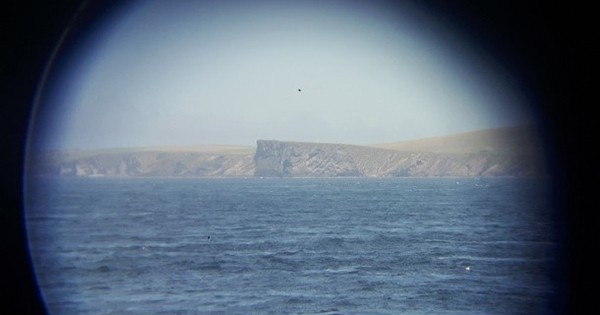
The first sampling day, last Sunday, started with helping the other people carrying huge amounts of sea water from the CTD towards their containers. While the others were busy with their experiments with water samples, I started to prepare the in-situ pumps for their first pumping sessions. These pumps go to a certain depth in the ocean to pump water through a filter for an hour or more. The pumps worked perfectly, so I collected a lot of material on the filters. In the afternoon, the multicore went down to the bottom of the Atlantic Ocean to collect sediment top cores, which also went well, making the first day for me a great success! Sven and I even spotted live bioturbation in the sediment (a worm crawled out of it).
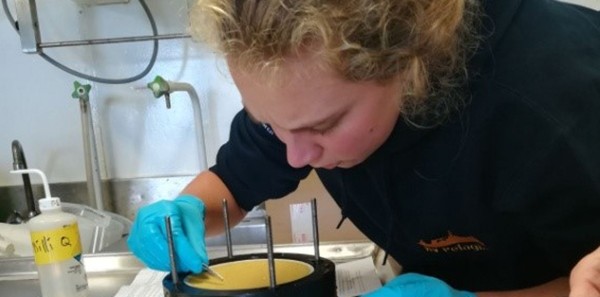
On our first day, everything went quite slow, making it a long day. But as a lot of things went well, everybody was quite happy and nobody seemed to care about working late. Also Bastiaan, who had been in his container from early in the morning till late in the evening, was still smiling at 11 p.m., while finishing the last things of the day.
For me, it had been such a successful day that I happily volunteered to finish an experiment of Tessa, which had to happen at 1.30 a.m. because of delay earlier that day. Of course, a few hours later I was wondering why on earth I volunteered to do that. Meanwhile (two days later), we are getting used to the work and it goes a lot faster. But new things come up and so, few were late for dinner the last days (but luckily the cook saves them enough food).
It is good to see that everybody is helping each other were possible, not only to make the work go faster, but also because we are interested in what the others do. For me all the biological stuff is new and therefore nice to help with, but I have definitely caught a few biologists being jealous of me playing with clay instead of with water, so they were eager to help me, lucky me!

Blog 3 by Sven Pont, MSc-student, Radboud University Nijmegen
22/7/2017
Now I am writing on the top of the boat above the captains workplace, typing in the cloudless sky with 24°C on deck. Today was the day of the test samples. The CTD (a device with various large tubes able to close separately of each other to take water samples from different depths) went overboard to collect the samples. The goal was to allow for a trial for all researchers who sample and process seawater; to check whether all works and whether all fits the time schedule. Stressful but giving much desired insight how it all goes. It was a good day for me.
23/7/2017
This morning my alarm went off at 6 AM to prepare the tests which had to be started around 8 AM. In these two hours I did my preparations, a fast breakfast at 7 and continued after until a quarter to 8. I was ready! In the meantime our breakfast was interrupted when someone come into the bar and said that there were long-finned pilot whales near the boat. And yes, there were!! Maybe 30 together, so the first day of real sampling started with a nice welcomes committee. Luckily I prepared all my stuff in the early morning which gave me some time to enjoy their presence.
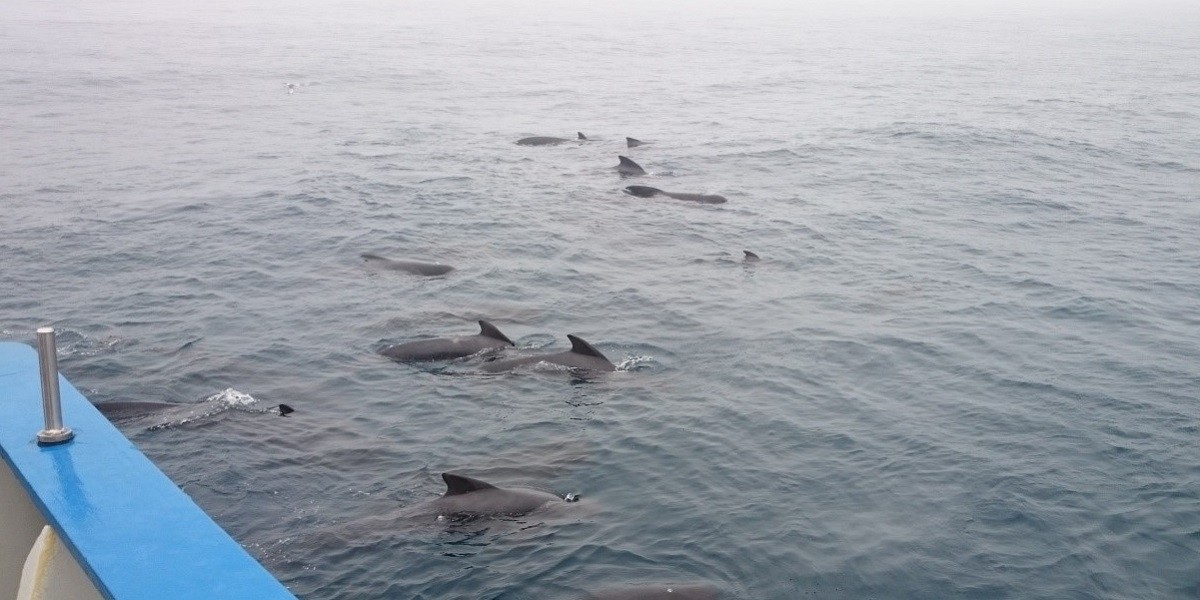
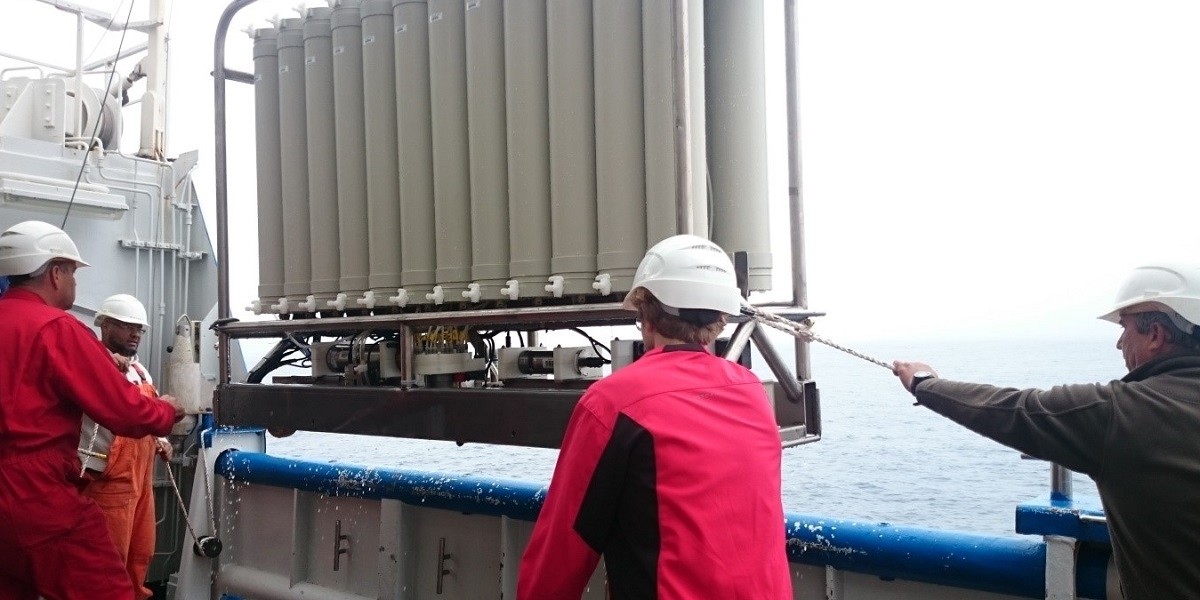
Just before 8 the CTD was up on deck and shortly later the seawater I needed was put into dedicated bottles and the first station started in my temperature climatized lab container. Although not all went smoothly, there were no big issues that could be overcome. I finished at 10:45, so 15 minutes to prepare for the next CTD from which I get my water samples. This time it went smooth, so that was a good thing!! I adapted the protocols slightly and evaluated how the day went to be sure that tomorrow everything will go well again.
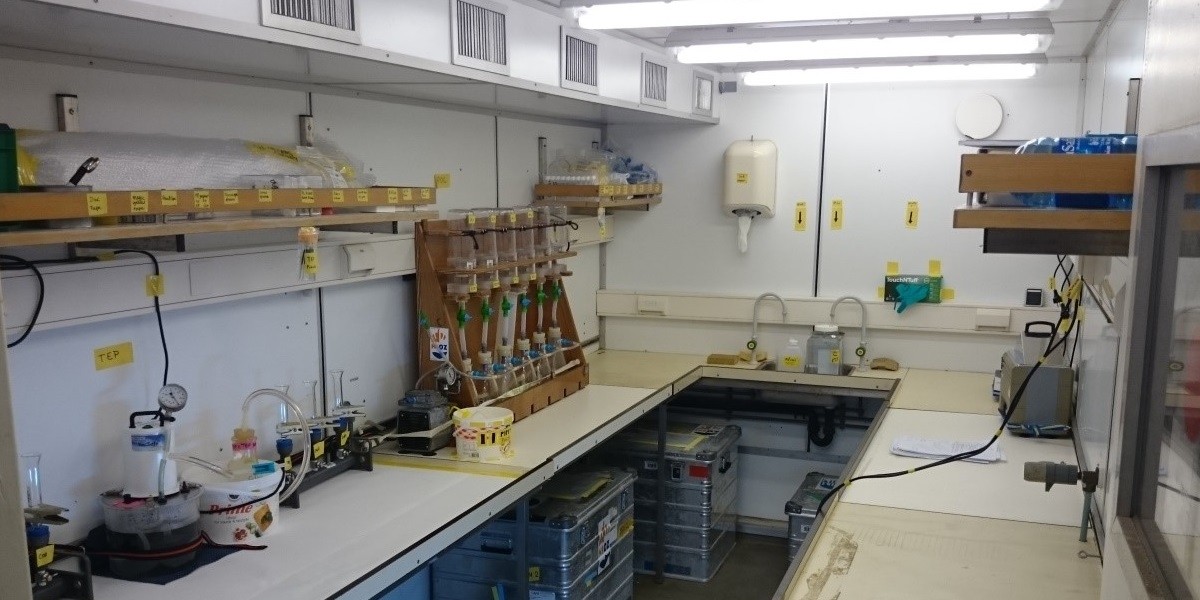
Blog 2 by PhD'er Mathijs van Manen, Utrecht University - Tracing metals
I have just started my PhD-project at NIOZ about trace metals, especially iron, in the ocean. This is my first time on a scientific cruise and since my background isn’t marine sciences almost everything I see or do is new. With me there are several students joining a cruise for the first time and because of this it is perfect we have some days to prepare ourselves before the first real station starts. My work on the ship will mainly be measuring the iron concentrations of water using flow injection analysis, being part of the tapping-team; and flipping out of the tablecloths after lunch and diner (a task that cannot be underestimated ). I work with Rob and Loes and we used the transit days to calibrate the system and trying to fix some small bugs. Hopefully everything will be ready to use for tomorrow when we reach our test station!
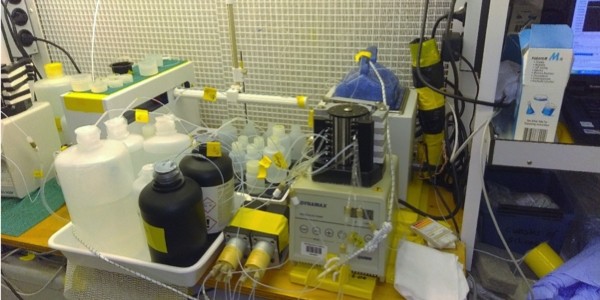
Life onboard is fascinating! While being awake we practically work all the time. However, of course beside the work there is plenty of stuff to see and do. I absolutely love going outside to see the sunrise/sunset, the rocking of the ship and the inconvenience it causes and meeting all this new people from different backgrounds and professions. Also, the view is sometimes absolutely stunning. Yesterday for instance we passed the northern coast of Scotland and had some beautiful views on the small islands, cliffs and many birds (including a couple of puffins!). I also learned that there is no need to point at containerships, gannets or other birds to the crew since it’s not their first time on the ship, and that the lunch is a very stressful time since half an hour for 3 courses is short I noticed. All very useful experiences!
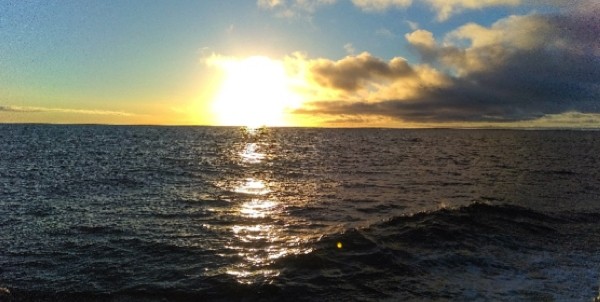
Blog 1 by Tessa de Bruin, MSc-student - Trossen los en gaan!
’s Avonds rond half zeven is het dan eindelijk zover: Onderzoeksschip de Pelagia vertrekt vanuit de haven van het NIOZ voor een vier weken lange tocht. Eindbestemming? Tenerife! Hoewel we pas om half zeven vertrokken, begon de reis eigenlijk al ’s ochtends toen iedereen aankwam en alle medeopvarenden voor het eerst in levende lijve ontmoette. Iedereen kent weliswaar een paar anderen maar niemand kent iedereen. Bovendien weet niemand nog wat we nu precies gaan doen de komende weken. Daarom beginnen we met een introductie van Corina en een voorstelrondje.
In totaal zijn we met 25 mensen waarvan 11 bemanningsleden en 14 wetenschappers. Ons voorstelrondje beperkte zich tot de wetenschappers aangezien de bemanning druk aan het werk was. Onze groep blijkt een mengsel van geowetenschappers en biologen uit Utrecht, Leiden en Amsterdam. Opvallend is dat we allemaal Nederlands praten (op een bemanningslid na maar hij verstaat het stiekem wel). Bovendien zijn de meeste van ons net of nog net niet begonnen aan een wetenschappelijke carrière. Sommige zijn (net) bezig met een PhD, anderen zijn hun master aan het afronden. Natuurlijk zijn er ook een paar ervaren wetenschappers en medewerkers mee om alles in goede banen te leiden.
Omdat het een paar dagen varen is naar het eerste station, kunnen we rustig opstarten. De sfeer is dan ook ontspannen. Na de introductie blijkt dat er een vriezer kapot is waardoor een deel van de voedselvoorraad naar een andere vriezer een paar trappen lager verplaatst moet worden. Iedereen helpt mee door een ketting te vormen en zo is de klus snel geklaard. Over voedsel gesproken, we eten ’s middags warm dat is even wennen. Na het avondeten is er nog de veiligheids-oefening en daarna is er tijd voor een biertje op het achterdek. Het belooft een mooie reis te worden!
